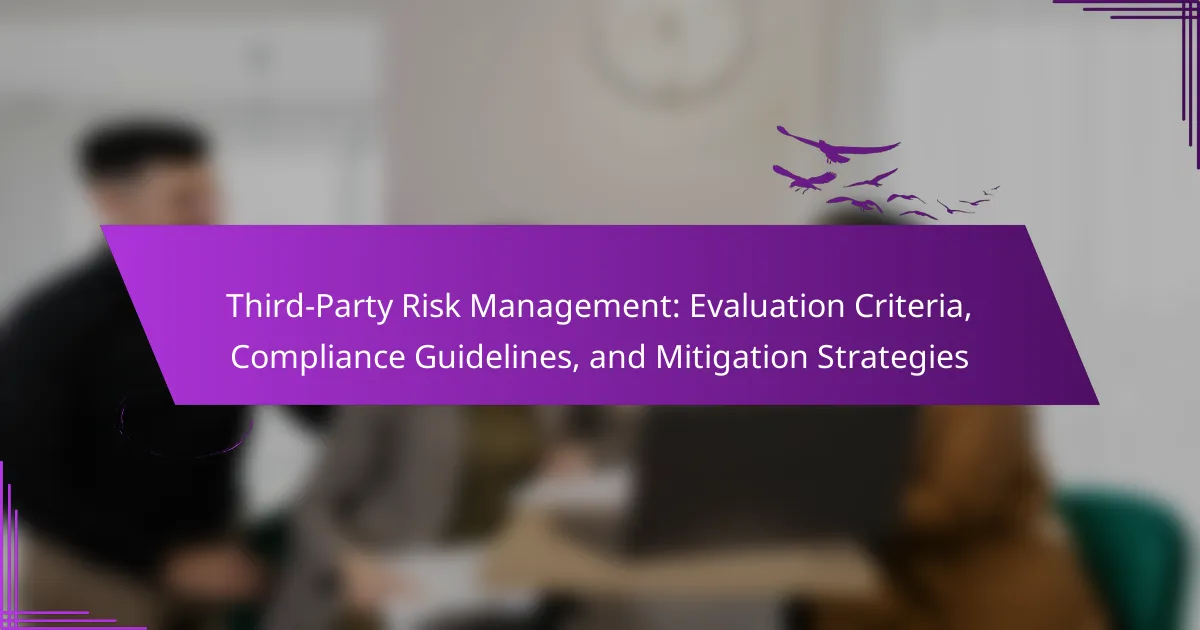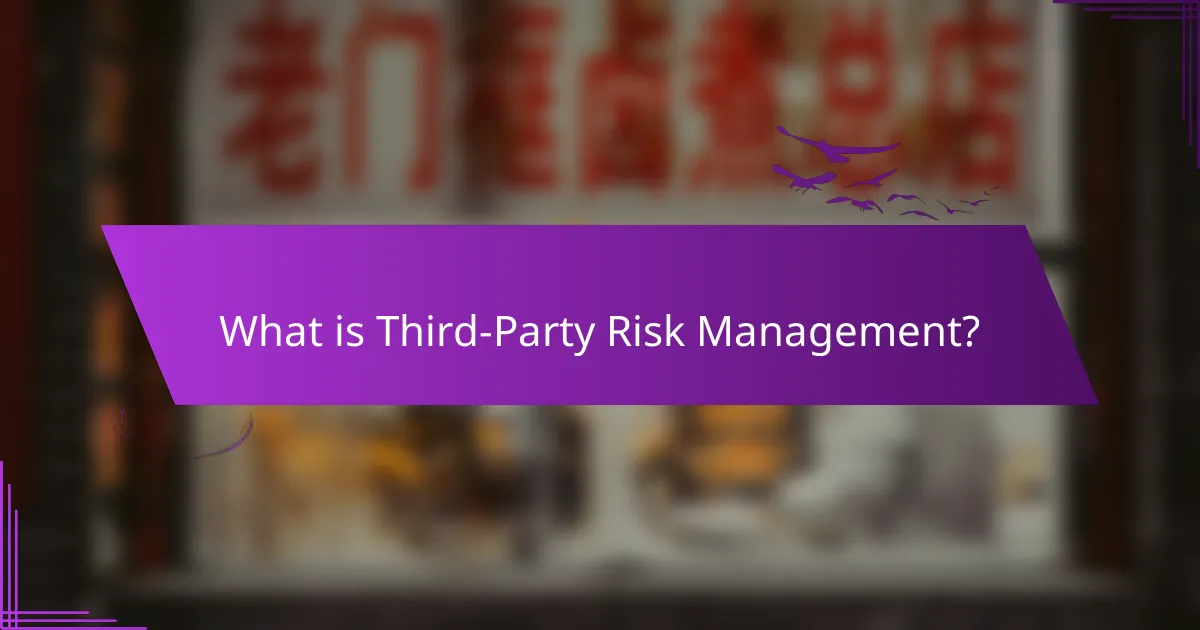
What is Third-Party Risk Management?
Third-Party Risk Management is the process of identifying, assessing, and mitigating risks associated with third-party relationships. Organizations rely on external vendors, suppliers, and partners, which can introduce various risks. These risks include operational, financial, reputational, and compliance-related threats. Effective third-party risk management helps organizations protect their assets and maintain compliance with regulatory requirements. According to a study by the Ponemon Institute, 59% of organizations experienced a data breach caused by a third party. This highlights the importance of robust risk management practices in safeguarding sensitive information.
Why is Third-Party Risk Management important for organizations?
Third-Party Risk Management is crucial for organizations to safeguard their operations. It helps identify, assess, and mitigate risks associated with external vendors and partners. Effective management of these risks prevents potential financial losses and reputational damage. According to a 2021 study by Deloitte, 70% of organizations experienced a third-party risk event in the past year. This statistic underscores the importance of proactive risk management strategies. Additionally, regulatory compliance often necessitates robust third-party risk management frameworks. Organizations that neglect this aspect may face legal penalties and operational disruptions. Thus, integrating third-party risk management into business practices is essential for long-term sustainability and security.
What are the potential consequences of neglecting Third-Party Risk Management?
Neglecting Third-Party Risk Management can lead to significant financial losses and reputational damage. Organizations may face data breaches due to inadequate vendor security measures. This can result in legal liabilities and regulatory fines. Poorly managed third-party relationships can disrupt business operations. Companies may also experience loss of customer trust and loyalty. According to a study by the Ponemon Institute, 59% of organizations suffered a data breach due to third-party vendors. Furthermore, the average cost of a data breach is estimated at $4.24 million, emphasizing the financial impact of neglecting this area.
How does Third-Party Risk Management fit into overall risk management strategies?
Third-Party Risk Management (TPRM) is a critical component of overall risk management strategies. It identifies and assesses risks posed by external entities that an organization interacts with. TPRM ensures that risks from third parties do not adversely affect the organization’s operations or reputation. Effective TPRM integrates with broader risk management frameworks, providing a comprehensive view of potential vulnerabilities. Organizations that implement TPRM can better mitigate risks associated with supply chain disruptions, data breaches, and compliance failures. According to a 2021 study by Deloitte, 78% of organizations recognized third-party risks as a top concern in their risk management strategies. This highlights the importance of TPRM in safeguarding organizational integrity and resilience.
What are the key components of Third-Party Risk Management?
The key components of Third-Party Risk Management include risk assessment, due diligence, contract management, monitoring, and compliance. Risk assessment identifies potential risks associated with third-party relationships. Due diligence involves evaluating the third party’s financial stability and operational capabilities. Contract management ensures that agreements include risk mitigation clauses. Monitoring is the ongoing evaluation of third-party performance and risk exposure. Compliance ensures adherence to relevant regulations and internal policies. These components collectively contribute to effective management of third-party risks.
What types of risks are associated with third-party relationships?
Third-party relationships are associated with various risks including operational, reputational, compliance, and financial risks. Operational risks occur when third parties fail to deliver services as promised, leading to disruptions. Reputational risks arise if third parties engage in unethical practices, affecting the primary entity’s image. Compliance risks relate to third parties not adhering to regulatory standards, which can result in legal penalties. Financial risks can emerge from third-party failures that lead to unexpected costs or losses. According to a report by Deloitte, 79% of organizations experienced a third-party risk event in the past three years, highlighting the prevalence of these risks.
How are third-party vendors categorized based on risk levels?
Third-party vendors are categorized based on risk levels into low, medium, and high risk. Low-risk vendors typically pose minimal impact on the organization’s operations or data. Medium-risk vendors may have moderate access to sensitive information but are generally manageable. High-risk vendors have significant access to critical data or systems, posing a substantial risk to the organization. This categorization is often determined by assessing factors such as data sensitivity, regulatory requirements, and the vendor’s operational stability. Organizations may conduct risk assessments and audits to validate these categorizations.
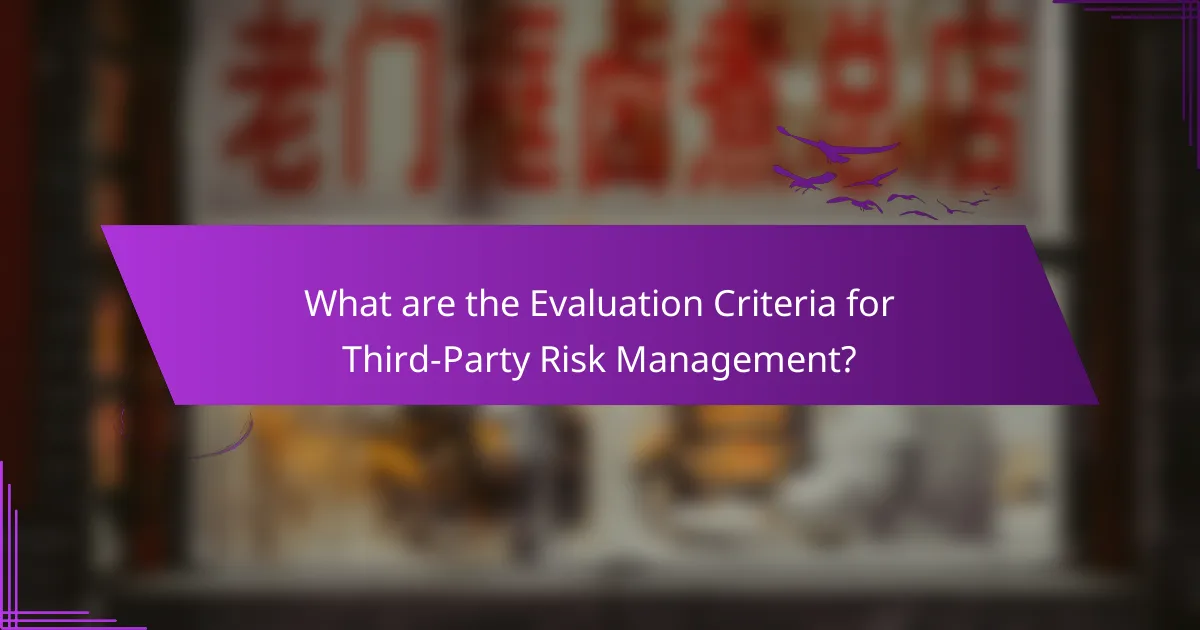
What are the Evaluation Criteria for Third-Party Risk Management?
Evaluation criteria for third-party risk management include assessing financial stability, compliance with regulations, and data security measures. Financial stability evaluates a third party’s ability to meet obligations. Compliance ensures adherence to relevant laws and industry standards. Data security measures assess how well a third party protects sensitive information. Additionally, operational resilience and reputation risk are crucial factors. Operational resilience examines a third party’s ability to continue operations during disruptions. Reputation risk considers the potential impact on your brand from third-party actions. These criteria help organizations make informed decisions about third-party partnerships.
What factors should be considered when evaluating third-party vendors?
Key factors to consider when evaluating third-party vendors include their financial stability, reputation, compliance with regulations, and quality of services. Financial stability indicates a vendor’s ability to fulfill contracts. A solid reputation can be assessed through customer reviews and case studies. Compliance with relevant regulations ensures that the vendor adheres to legal and industry standards. Quality of services can be evaluated through performance metrics and service level agreements. Additionally, consider the vendor’s security protocols to protect sensitive data. Assessing these factors helps mitigate risks associated with third-party relationships.
How do compliance requirements influence evaluation criteria?
Compliance requirements directly shape evaluation criteria by establishing mandatory standards for performance and accountability. Organizations must align their evaluation processes with these legal and regulatory frameworks. This alignment ensures that all third-party engagements meet compliance standards, reducing potential risks. Compliance requirements often dictate specific metrics for assessing vendor performance. For instance, data protection laws may require evaluations to include cybersecurity measures. Additionally, compliance frameworks may necessitate regular audits and reporting, influencing how evaluations are structured. Adhering to these requirements can enhance trust and transparency in third-party relationships. Ultimately, compliance-driven evaluation criteria help organizations mitigate risks associated with non-compliance.
What role does financial stability play in vendor evaluation?
Financial stability is crucial in vendor evaluation. It indicates the vendor’s ability to meet financial obligations. Vendors with strong financial health are less likely to default on contracts. This reduces the risk of service disruption for the evaluating organization. Financial metrics like revenue trends and profit margins provide insight into stability. Research shows that financially stable vendors contribute to long-term partnerships. A study by Dun & Bradstreet found that 70% of businesses prioritize financial stability in vendor selection. Thus, assessing financial stability is essential for effective third-party risk management.
How can organizations assess the effectiveness of their evaluation criteria?
Organizations can assess the effectiveness of their evaluation criteria by conducting regular reviews and analyses. This involves comparing the outcomes of evaluations against predefined goals and objectives. Utilizing quantitative metrics, such as performance scores or compliance rates, provides measurable insights. Qualitative feedback from stakeholders can also highlight areas for improvement. Benchmarking against industry standards helps identify gaps in the evaluation process. Furthermore, organizations should implement a feedback loop to continuously refine their criteria based on assessment results. This approach ensures that evaluation criteria remain relevant and effective over time.
What metrics can be used to measure the success of third-party evaluations?
Key metrics to measure the success of third-party evaluations include compliance rates, performance scores, and stakeholder satisfaction levels. Compliance rates assess adherence to regulatory requirements and internal policies. Performance scores evaluate the effectiveness and efficiency of third-party services. Stakeholder satisfaction levels gauge the perceived value and quality of the third-party relationship. These metrics provide quantifiable data to determine the effectiveness of evaluations. Regular analysis of these metrics can inform decision-making and improve third-party management strategies.
How often should evaluation criteria be reviewed and updated?
Evaluation criteria should be reviewed and updated at least annually. Regular reviews ensure that the criteria remain relevant and effective. Changes in regulations, industry standards, or organizational goals may necessitate updates. Additionally, feedback from stakeholders can provide insights for improvement. Consistent evaluation helps mitigate risks associated with third-party relationships. Organizations that implement annual reviews are better equipped to adapt to evolving risks. This practice aligns with best practices in risk management and compliance standards.
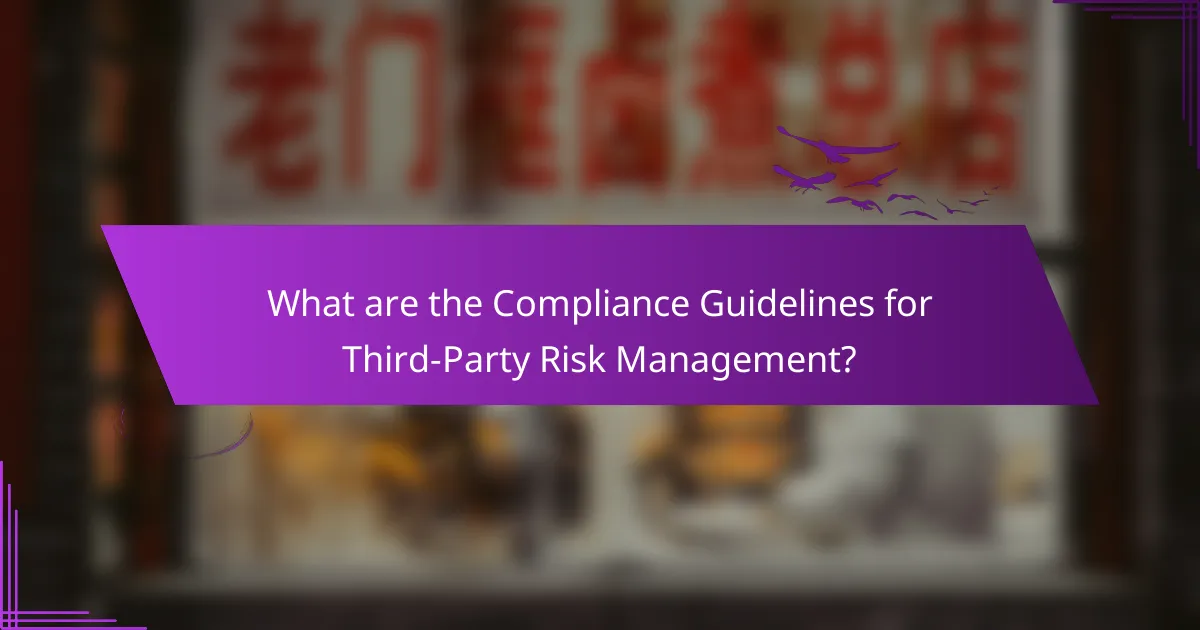
What are the Compliance Guidelines for Third-Party Risk Management?
Compliance guidelines for third-party risk management involve a structured approach to identify and mitigate risks associated with external partnerships. Organizations must conduct thorough due diligence on third parties to assess their financial stability, reputation, and compliance with applicable laws. Regular monitoring of third-party performance and risk exposure is essential. This includes evaluating their cybersecurity measures, operational capabilities, and adherence to contractual obligations. Documentation of all assessments and decisions is crucial for accountability and regulatory compliance. Organizations should also establish clear communication channels with third parties to address issues promptly. Following these guidelines helps ensure that third-party relationships do not expose the organization to undue risks.
What regulations impact Third-Party Risk Management practices?
Regulations impacting Third-Party Risk Management practices include the Sarbanes-Oxley Act, GDPR, and the Dodd-Frank Act. The Sarbanes-Oxley Act mandates financial transparency and accountability, affecting how organizations manage third-party vendors. GDPR imposes strict data protection requirements, influencing third-party data handling. The Dodd-Frank Act emphasizes risk management in financial institutions, requiring due diligence on third-party relationships. Other relevant regulations include HIPAA for healthcare data and PCI DSS for payment card information. Compliance with these regulations is essential for effective third-party risk management.
How do industry standards shape compliance guidelines?
Industry standards significantly influence compliance guidelines by establishing benchmarks for acceptable practices. These standards provide a framework that organizations must follow to ensure regulatory adherence. Compliance guidelines are often derived from these established standards to maintain consistency across the industry. For example, the ISO 27001 standard outlines information security management practices. Organizations that align their compliance guidelines with ISO 27001 can better manage third-party risks. This alignment helps in mitigating potential vulnerabilities associated with external partners. Additionally, adherence to industry standards can enhance an organization’s credibility and trustworthiness. Thus, industry standards play a crucial role in shaping effective compliance guidelines.
What best practices should organizations follow to ensure compliance?
Organizations should implement a comprehensive compliance program. This program must include regular training for employees on compliance policies. Organizations should conduct risk assessments to identify compliance gaps. They must establish clear policies and procedures that align with regulations. Regular audits and monitoring of compliance practices are essential. Organizations should maintain accurate records to demonstrate compliance efforts. They must foster a culture of compliance within the organization. Engaging with legal and compliance experts ensures adherence to regulations.
How can organizations maintain transparency in their third-party relationships?
Organizations can maintain transparency in their third-party relationships by implementing clear communication protocols. This includes establishing regular reporting schedules for third-party performance and compliance. Organizations should also conduct thorough due diligence before engaging with third parties. This process involves assessing the financial stability and ethical practices of potential partners.
Furthermore, organizations must ensure that contracts with third parties include transparency clauses. These clauses should mandate the disclosure of relevant information and compliance with industry standards. Regular audits and assessments can also help verify adherence to transparency requirements.
According to a study by the Institute for Supply Management, organizations that prioritize transparency in supplier relationships report improved performance and reduced risks. This demonstrates that transparency not only fosters trust but also enhances operational efficiency.
What documentation is essential for compliance in Third-Party Risk Management?
Essential documentation for compliance in Third-Party Risk Management includes risk assessment reports, vendor contracts, and due diligence documentation. Risk assessment reports detail potential risks associated with third-party relationships. Vendor contracts outline the terms and conditions governing the relationship. Due diligence documentation verifies the third party’s compliance with regulatory requirements. Additional essential documents may include audit reports and performance evaluations. These documents ensure transparency and accountability in managing third-party risks. Compliance with regulations often mandates the maintenance of such documentation to mitigate risks effectively.
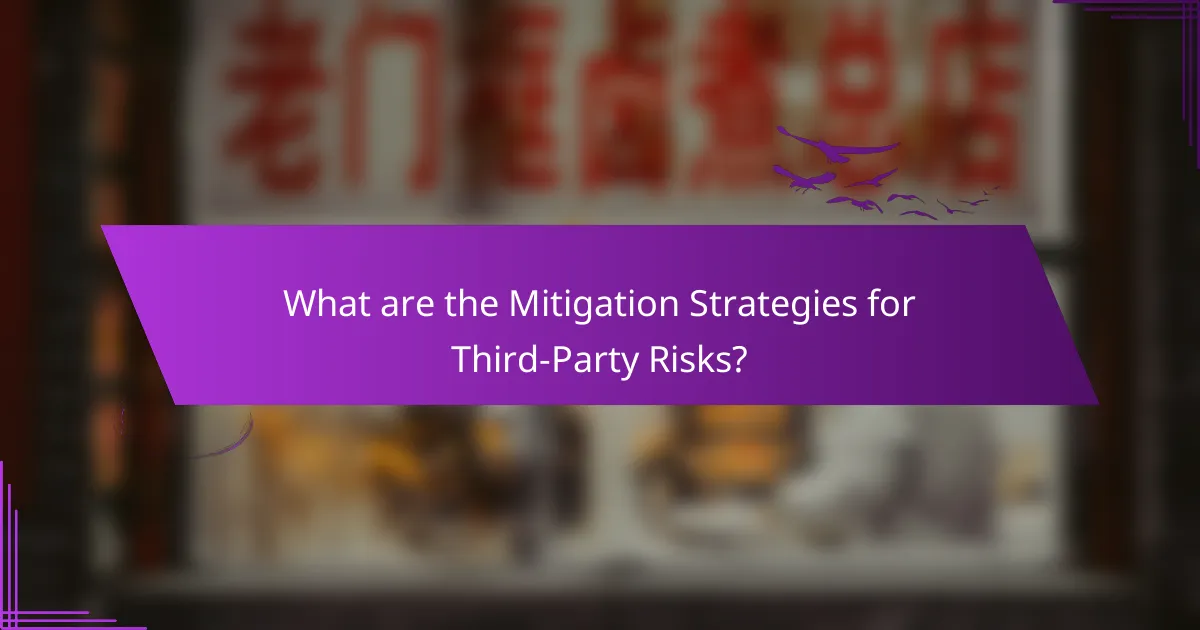
What are the Mitigation Strategies for Third-Party Risks?
Mitigation strategies for third-party risks include thorough due diligence, contract management, and ongoing monitoring. Conducting due diligence helps identify potential risks associated with third parties. This process involves assessing financial stability, compliance history, and operational capabilities. Effective contract management ensures that agreements outline risk responsibilities and liability limits. Regular monitoring of third-party performance is essential to identify emerging risks. Implementing audits and assessments can provide insights into compliance and operational effectiveness. Establishing clear communication channels fosters transparency and quick response to issues. Training internal teams on third-party risk management enhances awareness and preparedness. These strategies collectively reduce the likelihood and impact of third-party risks.
What proactive measures can organizations take to mitigate third-party risks?
Organizations can implement several proactive measures to mitigate third-party risks. Conducting thorough due diligence on potential partners is essential. This includes assessing their financial stability and compliance history. Regularly monitoring third-party performance helps identify emerging risks. Establishing clear contractual obligations and expectations is crucial. Organizations should also implement robust cybersecurity measures to protect sensitive data. Training employees on third-party risk awareness enhances overall risk management. Lastly, developing a comprehensive risk management framework provides a structured approach to ongoing risk assessment. These measures collectively strengthen an organization’s resilience against third-party risks.
How can organizations develop effective risk mitigation plans?
Organizations can develop effective risk mitigation plans by conducting thorough risk assessments. This involves identifying potential risks associated with third-party relationships. Organizations should evaluate the likelihood and impact of each risk. They must prioritize risks based on their potential effects on operations. Developing strategies to address each identified risk is crucial. These strategies may include risk avoidance, transfer, acceptance, or reduction. Regularly reviewing and updating the risk mitigation plan is essential for ongoing effectiveness. Additionally, engaging stakeholders in the process enhances the plan’s comprehensiveness. Research indicates that organizations with structured risk management frameworks experience fewer disruptions.
What role does continuous monitoring play in risk mitigation?
Continuous monitoring is essential for effective risk mitigation in third-party risk management. It allows organizations to identify potential risks in real-time. By continuously assessing third-party activities, organizations can detect changes in risk profiles promptly. This proactive approach enables timely interventions before risks escalate. Research indicates that organizations employing continuous monitoring reduce risk incidents by up to 30%. Regular updates and assessments help maintain compliance with regulatory standards. Continuous monitoring also fosters transparency and accountability among third parties. Overall, it enhances an organization’s ability to manage risks effectively and safeguard its interests.
How can technology assist in monitoring third-party risks?
Technology assists in monitoring third-party risks by automating data collection and analysis. It enables real-time monitoring of third-party activities and compliance. Tools like AI and machine learning identify potential risks through data patterns. Automated alerts notify stakeholders of any risk changes. Blockchain technology ensures transparency in transactions and relationships. Risk assessment software evaluates third-party performance against compliance standards. According to a Deloitte report, 78% of organizations use technology for risk management. This integration enhances decision-making and reduces human error. Overall, technology streamlines the risk monitoring process, making it more efficient and effective.
What are the common challenges in implementing Third-Party Risk Management strategies?
Common challenges in implementing Third-Party Risk Management strategies include lack of standardized processes, insufficient data on third parties, and resource constraints. Organizations often struggle with inconsistent evaluation criteria across different vendors. This inconsistency can lead to gaps in risk assessment. Additionally, many companies lack comprehensive visibility into their third-party relationships. This lack of visibility makes it difficult to monitor compliance and performance effectively. Resource constraints also hinder the ability to conduct thorough due diligence. Many organizations do not have dedicated teams for managing third-party risks. Furthermore, regulatory compliance can be complex and varies by region, complicating implementation efforts. These challenges collectively impact the effectiveness of Third-Party Risk Management strategies.
How can organizations overcome obstacles in Third-Party Risk Management?
Organizations can overcome obstacles in Third-Party Risk Management by implementing a structured approach. This includes conducting thorough due diligence on third-party vendors. Organizations should assess financial stability, compliance history, and operational capabilities. Regular audits and risk assessments can identify potential vulnerabilities. Establishing clear communication channels fosters transparency and accountability. Training staff on risk management practices enhances awareness and preparedness. Utilizing technology solutions can streamline monitoring and reporting processes. Research shows that companies with robust risk management frameworks experience fewer disruptions.
What practical tips can organizations apply to enhance Third-Party Risk Management?
Organizations can enhance Third-Party Risk Management by implementing a robust vendor assessment process. This involves evaluating potential third-party vendors against predefined risk criteria. Regularly reviewing vendor performance and compliance is essential. Organizations should also establish clear communication channels with third parties. This ensures timely reporting of risks and issues. Implementing a risk monitoring system can provide real-time insights. Training staff on risk management practices is crucial for awareness. Lastly, developing a comprehensive incident response plan prepares organizations for potential breaches. These strategies collectively strengthen Third-Party Risk Management efforts.
Third-Party Risk Management (TPRM) is the process of identifying, assessing, and mitigating risks associated with external vendors, suppliers, and partners. This article outlines the importance of TPRM in safeguarding organizational assets and ensuring compliance with regulatory requirements, while highlighting potential consequences of neglecting these practices. Key components include risk assessment, due diligence, contract management, monitoring, and compliance, with specific evaluation criteria and mitigation strategies discussed to enhance effective management. The article also addresses challenges organizations face in implementing TPRM and offers practical tips to strengthen their risk management frameworks.
